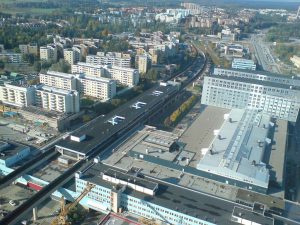Smart City- Smarter Ways to Sustainable Living

Urbanization is an indicator of poverty reduction and hence can serve as a valuable indicator of the overall economic growth of the country. Urbanisation is an irreversible yet a very important process. India is also in the middle of a transition from rural to a quasi urban economy with a dramatic increase in the number of large cities. India’s urban population currently residing in five thousand two hundred agglomerations has increased from 285 million to 380 million since 2001 to 2011. It is projected that by 2030, 600 million people would live in urban areas out of a total population of 1.4 billion and the GDP contribution of 63% by the current urban population would increase to 75%. It requires the development of physical, social, institutional and economic infrastructure to improve the living standards of the people and to attract investments. Hence, smart cities would assist in development and sustainable growth. The smart city mission is an initiative covering 100 cities for a period of five years until the Ministry of Urban Development evaluates the mission and incorporates the lessons learnt to accomplish sustainable growth and development.
Smart city is a concept that differs from one country to the other depending on various factors like willingness to reform, resources, level of development and aspirations of the people. The primary aim behind a smart city is the holistic growth of an urban ecosystem involving economic, physical, social and institutional development. The overall development towards achieving the goal of being a smart city is a long term goal, which can be approached in an incremental manner, adding layers of “smartness” each time. A smart city would be the one equipped with such infrastructural elements as provision for proper electric and power supply (solar power should account for 10% energy requirements), sanitation ( including provisions for solid waste management), efficient public transport and urban mobility, good governance including e-governance, sustainable environment, adequate water supply (including storm water reuse and waste water recycling), etc. Planned development through promotion of mixed land use, availability of housing opportunities for all, reduction in pollution, resource depletion, congestion, improving connectivity and enhancing local economy, development of parks and other recreational spaces, smart solutions like reducing vulnerability towards disasters are some important features of a smart city.
There is no proposed model for a smart city, each city is expected to propose and develop their own plan according to local requirements, resources and ambitions for which they may derive technical support from consulting firms and handholding agencies. The proposed model for each shortlisted city should incorporate either of the following strategies – retrofitting, redevelopment, Greenfield or its mixture and a pan-city feature. The description of the strategy is as follows-
- Retrofitting incorporates the development of an existing area to achieve the status of a smart city. An area of more than five hundred acres would be identified as a city in consultation with the citizens under retrofitting. The strategy is likely to be completed in a much smaller time frame as it involves the development of an existing structure with additional infrastructural services and intensive smart applications.
- Redevelopment envisages an area identified by Urban Local Bodies of more than fifty acres in consultation with citizens. This strategy intends to co-create a novel layout with improved infrastructure by increased density and mixed land use. Saifee Burhani Upliftment Project, Mumbai and East Kidwai Nagar, New Delhi are examples of redevelopment model.
- Greenfield involves the development of a previously vacant area of more than two-fifty acres using innovative planning, financing and implementation tools to provide smart solutions. Steps like land reconstitution are an important feature of Greenfield development strategy to provide affordable housing facilities to all especially the poor. It can be within the limits of Urban Local Body or Local Urban Development Authority, unlike retrofitting and redevelopment. GIFT city in Gujarat is an example of Greenfield strategy.
- Pan city is an additional feature which is to be applied to the existing city-wide infrastructure. It is the use of smart solution involving the use of data, information, and technology to provide people with better facilities like wastewater treatment, reduced commuting time and costs, etc.
The implementation of the smart city mission is to be done by Special Purpose Vehicle (SPV). SPV’s have the responsibilities like planning, appraisal, approval, release of funds, implementation, management, operation, monitoring and evaluation of the project. SPV of each smart city is to have nominees from Urban Local Body, state government, union government and headed by a CEO to look after the responsibilities and ensure execution of the project through different measures like joint ventures, Public Private Partnerships, subsidiaries, etc. The smart city project will be financed by the central government which intends to finance support to the extent of rupees forty-eight thousand crores over a period of five years. Substantial fund requirement for the development is anticipated which would need funding from internal and external funding bodies which depends on the robustness and abilities of the revenue model developed by the SPV. States like Karnataka, Madhya Pradesh, Tamil Nadu, etc. have successfully established financial intermediaries for this purpose. To ensure proper implementation of the mission it is important to be monitored. Monitoring is hence done at the national level by an Apex Committee, at the state level by State level High Powered Steering Committee (HPSC) and by Smart City Advisory Forum at the city level.
The project involves a competitive method to decide and select cities for the project. Support from the state governments and Urban Local Bodies, investment of resources, proper governance, and active participation and proper understanding of retrofitting, redevelopment and greenfield development play a major decisive role in the success of the project. Integration of the institutional, physical, social and economic infrastructure is a necessity for comprehensive development. The Smart City Mission goal often converges with other schemes of the government and this can be used for effective utilization of resources to ensure the success of the project. The Atal Mission for Rejuvenation and Urban Transformation (AMRUT), Swachh Bharat Mission (SBM), Digital India, National Heritage City Development and Augmentation Yojana (HRIDAY), Housing for All, etc. have overlapping goals with the Smart City Mission which can be used to derive great benefits from the planning stage itself. The integration of these sectoral schemes is the key to finding a solution of many issues and is likely to establish effectively the vision of the project that is to provide a sustainable living for all.
Reference and further reading:
http://12thplan.gov.in/12fyp_docs/17.pdf
http://164.100.47.134/intranet/challengesofurbanization.pdf
http://www.smartcitynagpur.com/pdf/SmartCityGuidelines.pdf
The World’s Cleanest Cities – Explained in Infographic


